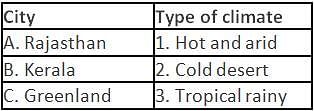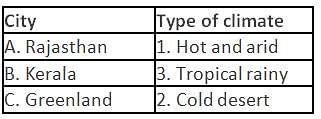Agriculture: CUET Mock Test - 2 - CUET Humanities MCQ
30 Questions MCQ Test Agriculture Practice Tests: CUET Preparation - Agriculture: CUET Mock Test - 2
Which of the following is a suitable time for transplanting of marigold?
| 1 Crore+ students have signed up on EduRev. Have you? Download the App |
Directions: In the following question, two statements are given. One is assertion and the other is reason. Examine the statements carefully and mark the correct answer according to the instructions given below
Assertion (A): Keeping beehives in crop fields during flowering period increases pollination efficiency.
Reason(R): Bees are the pollinators of many of our crop species such as sunflower, Brassica, apple and pear.
Assertion (A): Keeping beehives in crop fields during flowering period increases pollination efficiency.
Reason(R): Bees are the pollinators of many of our crop species such as sunflower, Brassica, apple and pear.
Which of the following tissues is present in the husk of coconut?
Aerobic respiration produces more usable chemical energy than fermentation because fermentation involves
What is the need for removing weeds from a crop field as early as possible?
(i) Weeds compete for food.
(ii) Weeds take up nutrients from the soil.
(iii) They reduce the yield of the main crop.
(iv) They cause diseases in the main crop.
Which of the following is not considered a benefit of kitchen gardening?
Which technology transfers genes from one organism to another to produce Genetically Modified Organisms (GMOs)?
Which of the following characteristics of alluvial soils is not true?
Which of the following fact about the propagation of fruits like mango is/are true?
(a) Only asexual propagation is required for growing mango.
(b) It is mainly propagated by grafting.
(c) Most suitable seedling for inarching method should be one year old.
In artificial insemination process, which of the following is/are introduced into the uterus of the female?
Which of the following is not a type of chemical fertiliser?
Why is the preparation of soil an important task in agriculture?
Which of these instruments is used in making irrigation efficient?
How much sampling depth is recommended for the field crops?
In which of the following groups are all compounds polysaccharides?
The deficiency symptoms of calcium and boron are generally observed on
Consider the following pairs.

Which of the given option is correctly matched?
Which of the following statements is/are correct regarding irrigation?
a. Irrigation helps in supplying the crops with hydrogen and oxygen.
b. Irrigation provides sufficient moisture for the germination of seeds.
c. Irrigation is essential for the growth and elongation of the roots.
Which of the following statements is not correct for fertilisers?
Which of the following options is not efficient in weed control?
Which of the following statements are incorrect regarding prokaryotic cell?
- Prokaryotic cells are smaller in size than eukaryotic cells.
- Site for oxidative phosphorylation is mitochondria.
- Ribosomal sub-units are 60S and 40S.
- Golgi apparatus is absent.
Given below are two statements:
- Statement I: Glycine is the simplest amino acid.
- Statement II: Glycine is optically active.
In light of the above statements, choose the most appropriate answer from the options given below:
What is the recommended length of cuttings for the cultivation of grapes?


















